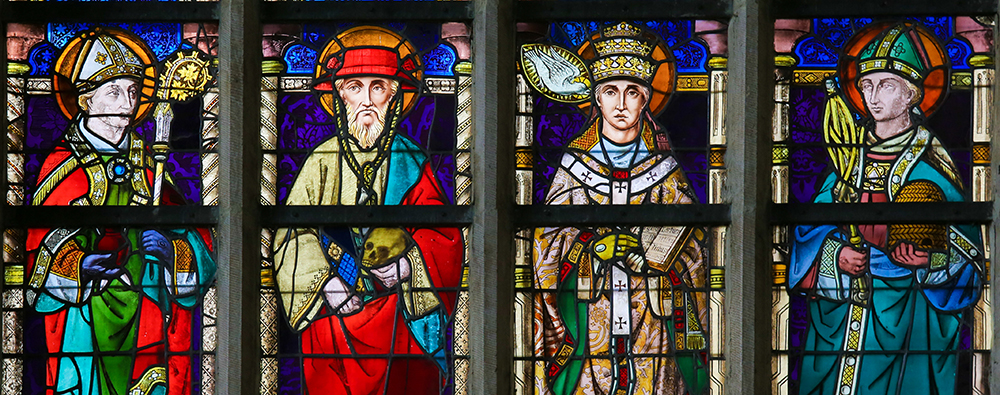When we hear the word “doctor,” we usually think first of a physician. But the word itself comes from the Latin docere, meaning “to teach.” It is in this literal sense that the title “Doctor of the Church” is bestowed on certain individuals whose teaching has greatly benefited the life of the Church.
The criteria for determining whether a person receives this title are a high degree of sanctity and great learning.
Investigation of a nominee’s sanctity is the responsibility of the Congregation for the Causes of Saints in Rome. The Congregation for the Doctrine of the Faith, also at the Vatican, makes the judgment about a nominee’s teaching. The latter congregation’s approval recognizes the contribution of the nominee’s doctrine, but does not guarantee that his or her writing contains no error.
With the approval of these two congregations, the Church proclaims a person to be a Doctor of the Church. This proclamation can be made by the pope or by an ecumenical council approved by him. In practice, all designations have been bestowed by the reigning pontiff.
The decree is made by a public proclamation of the pope. (This proclamation is not ex cathedra — that is, not an infallible declaration of the Church’s truth.) He also grants the universal Church the use of a Mass and an Office for the saint to whom the title of Doctor is given.
Some of the Doctors have been given special titles, reflecting their luminous reputations or significant themes in their thought: St. Augustine, for example, is Doctor Gratiae (Doctor of Grace); St. John of the Cross is Doctor Mysticus (Mystical Doctor); St. Cyril of Alexandria is Doctor Incarnationis (Doctor of the Incarnation).
Who Are the Doctors?
The naming of Doctors of the Church began in 1298, when Pope Boniface VIII named four eminent theologians and scholars as Doctors: St. Augustine, St. Ambrose, St. Jerome and St. Gregory the Great. In the Eastern Church, three Doctors were preeminent: St. John Chrysostom, St. Basil and St. Gregory Nazianzen.
Four women have received the title of Doctor in recent decades. Pope Paul VI bestowed the title on St. Teresa of Avila and St. Catherine of Siena in 1970. Pope John Paul II named St. Thérèse of the Child Jesus and the Holy Face a Doctor in 1997. Pope Benedict XVI so honored St. Hildegard of Bingen in 2012.
Presently, there are 36 Doctors of the Church: nine Eastern and 27 Western. Two were popes, 15 were bishops (archbishops, patriarchs, cardinals), one was a deacon, one a diocesan priest. Several were monks and a majority were members of religious congregations.
Eight religious orders are represented in the list of Doctors: Carmelites (3), Jesuits (2), Dominicans (3), Franciscans (3), and Benedictines (5) and one apiece for the Cistercians, Redemptorists and Oratorians.
Four Doctors were founders of religious orders: St. Alphonsus Liguori (Redemptorists), St. Teresa of Avila and St. John of the Cross (Discalced Carmelites), and St. Francis De Sales established an Oratory of St. Philip Neri and the Order of the Visitation of Holy Mary.
The national or ethnic identities of the Doctors of the Church include 11 Italians, 3 Syrians, 4 Anatolians, 4 French, 3 Spanish and 2 Germans. There is one each of the following: Armenian, North African, Dalmatian, Visigoth, Italian-English, Egyptian, Anglo-Saxon, Dutch, and Portuguese.
The Church does not act hastily in naming particular saints as Doctors of the Church. The average length of time between a saint’s death and the time of the proclamation is 815 years! It was an early saint, St. Ephraem, for whom the greatest number of years elapsed between his death and his being named a Doctor: 1,547 years. The most recent doctor of the Church — St. Gregory of Narek — was named by Pope Francis in 2015.
The shortest lapse of time was that of St. Alphonsus Liguori, proclaimed a Doctor of the Church just 84 years after his death. The next shortest interval was that of St. Thérèse of the Child Jesus: 100 years.
The longest life of all the Doctors is that of St. Alphonsus, who died at the age of 91. Yet not all the Doctors gained their wisdom over a long lifetime. The shortest life is that of St. Thérèse, who lived only 24 years. St. Catherine of Siena lived only 33 years, and St. Anthony of Padua, 36 years.
A Great Diversity
We find great diversity in the works for which the Doctors of the Church have been recognized. Some, such as St. Gregory the Great, St. Ambrose and St. Leo the Great, wrote many letters, homilies and short treatises. St. Thérèse composed only a single book — an autobiography — along with some poetry and personal correspondence.
St. Jerome was the first great biblical scholar, translating the entire Scripture into Latin and writing commentaries on biblical books. St. Augustine produced an enormous and varied corpus bearing on many aspects of theology. Like St. Robert Bellarmine, he defended the Church against onslaughts of heresy. Two from Avila, Spain were mystics: St. Teresa of Avila and St. John of Avila.
St. Ephraem and St. Gregory of Narek were celebrated hymnists. St. Bede’s history of the English people gives us our best information about England in the early Middle Ages. Systematic theologians such as St. Thomas Aquinas, St. Albertus Magnus, St. Anselm and St. Bonaventure all displayed deep wisdom in relating human knowledge to divine revelation.
Whatever their specialization, the Doctors have all served the Church as holy teachers, one of the great gifts of Christ to His people (see Eph 4:11-13). Through their labors, He has worked “to equip the holy ones for the work of ministry, for building up the body of Christ” (v. 12).

